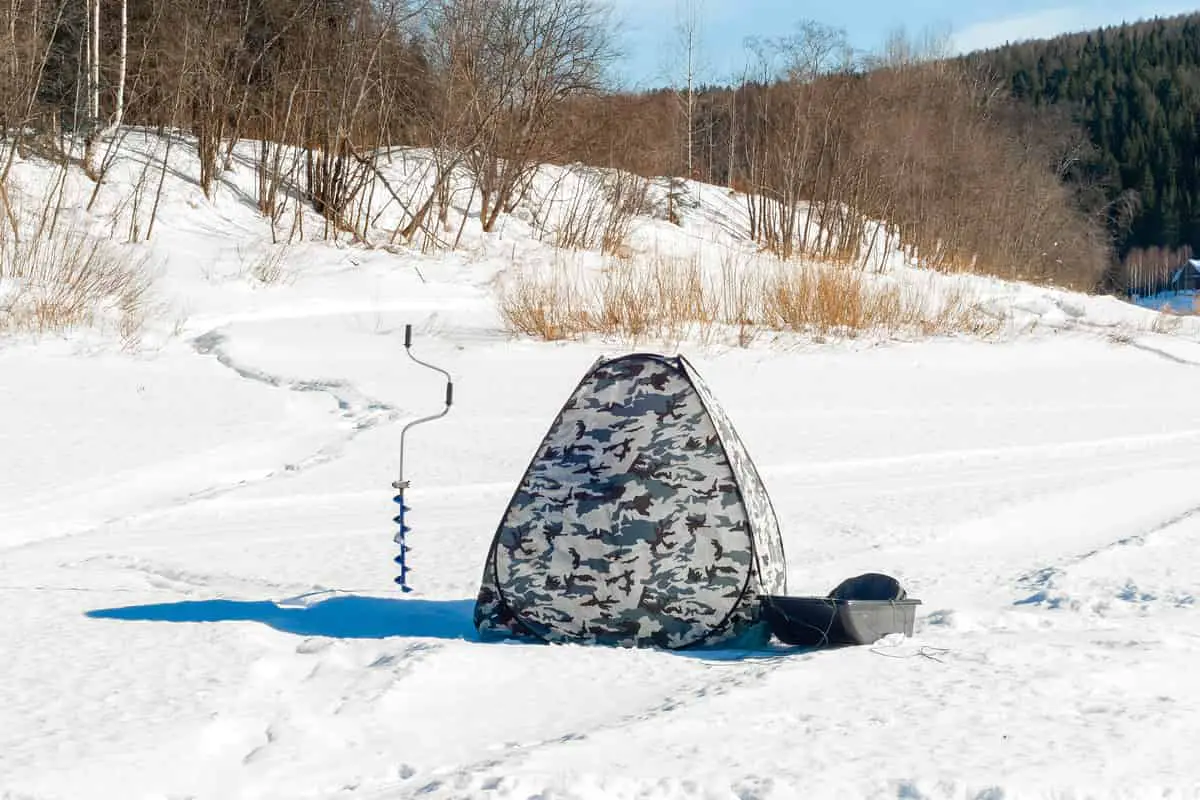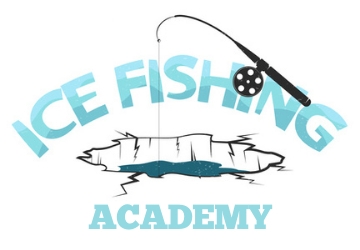Do you already own a good popup hunting blind and want to use it for ice fishing? You will want to do a few things to convert it to a solid ice fishing shelter!
Portable hunting blinds and popups can be used for ice fishing with proper preparation. Anchor the blind to the ice with adequate ice screw anchors or tie downs. Place grommets in the skirt for anchors and use snow or slush for banking the shelter’s bottom to keep the wind from blowing beneath it.
Getting inside a shelter and out of the wind while ice fishing makes a huge difference in your comfort on the ice.
While ice shelters are better designed for ice fishing, you can have a great day on the ice with your blind by taking the proper steps!

Consider the Smells and Odors on Your Hunting Blind
A lot goes on inside of an ice fishing popup! If you plan on hunting deer or another game that uses its sense of smell as a warning detector, you might want to reconsider using your hunting blind for ice fishing!
There will be odors and stains from your live baits, dead baits, and cut baits that are being used. Artificial scents and baits are popular and will leave their telltale marks behind as well.
If you heat your shelter with a propane heater, you’re also going to leave those propane odors behind!
I’ve cooked bacon & eggs, heated breakfast burritos wrapped in foil, and cans of soup and chili on my Mr. Heater Buddy propane heater. The odor of foods on your tent material will remain for a long time!
When you transport your shelter after using it for fishing, rolling it up, and storing it inside the carrying bag, all those smells and odors will permeate throughout the tent.
This may not be an issue if you’re hunting turkey, antelope near oil wells, or watering holes. But I wouldn’t want fish smell on my ground blind if I were hunting deer or bears!
What Are the Differences Between a Hunting Blind and an Ice Hub Tent?
As a general rule, the main differences are that a portable ice shelter is made from thicker tent material and insulated with 500g to 900g Thinsulate. They have plastic windows and a large skirt to bank the snow. The fiberglass poles are a larger diameter and built to withstand higher wind speeds.
I’ve seen hunting blinds that are not built as solid as an ice fishing hub tent. Ice fishing popups have better materials, hardware, and venting than hunting blinds.
Ice fishing shelters are designed to withhold heat and withstand fairly cold and high winds while sitting on an expansive sheet of flat ice.
Hunting blinds aren’t designed to keep you warm and sheltered once the midwinter sun goes down. They are designed to be lightweight, easy to transport, and most of all to conceal you from game animals.
In the end, a hunting blind isn’t designed to do what an ice fishing tent does. But if it’s the difference between fishing on open ice in the cold and wind or sitting inside of a hunting blind, I’d choose the hunting blind!
Don’t Forget Your Name and License on Your Shelter
There are States with laws about having your identification visibly affixed to the exterior of your ice shanty. Your State may also include having your address and phone number visible.
Heavy plywood permanent shanties are often left on the ice late in the season and are difficult to remove from the lake by the date deadline.
The shelters end up sinking into the lake. So game wardens are tasked to identify, ticket, and fine the people who own them.
Portable shelters are lost every year, so they must display their ID when on the ice.
An easy way to do this is to affix your requirements to the outside of your shanty, where it can be seen with velcro or in a clear plastic bag and secured with duct tape.
The easier way I’ve seen is by using a plastic deer license/tag holder. You will see hunters safety pinning these tag holders to the back of their orange hunting vests!
Check with your State’s local fishing regulations to see whether you need to display your ID on your shelter and how they specifically want it displayed.
Fiberglass Poles or Spring Setup Blinds for Ice Fishing – Which is Better?
There aren’t as many spring setup blinds as there used to be. Quick setup fiberglass poles are the norm now.
Fiberglass poles at one time needed to be threaded through sleeves before setting up the tent. That is no longer the case with the newer models.
With today’s ground blinds, most of them are set up by pulling them out from the sides, climbing inside, and popping up the roof if it has one. Quick and easy!
Spring setups are a bit more cumbersome, in my opinion, and don’t hold up as well in the wind.
For my money, I’ll take the ease of the fiberglass setup and the ability to flex in the wind when needed over the spring models.
But use whatever ground blind you have in your garage!
Anchoring Your Blind/Ice Shelter Is Key!
Ice shelter tents are designed with the winds you encounter on a lake that is iced over. Hunting ground blinds are not.
I’ve fished on some pretty windy days where I was standing flat-footed and being slowly blown across the ice!
With this in mind, you are going to want to secure your shelter to the ice. There are a few options when it comes to securing your shelters. The first one is my method!
Ice Anchors/Screws
I’ve used ice screws from different manufacturers and have found the Eskimo self-tapping ice anchors to be the best. They have large wide handles and an aggressive, coarse thread to grip the ice when first turning into the ice.
Other screw threads are too fine, in my opinion, and wallow out a hole, making it difficult for the screw to grab and turn into the ice securely.
If the wind isn’t too bad, you can get by by using just one ice screw on the upwind side of your shelter. If the wind becomes heavier or shifts around quite a bit, you’ll want to secure your shelter on all four sides.
If you have a cordless drill, I highly recommend adding the inexpensive HT Ice Drill Tool to your ice fishing kit!
With an anchor tool like this, the screws drive right in!
Pro Tip: Pour a little water down around the ice anchor after it’s seated into the ice. The water will freeze making a better anchor point.
Lag Bolts and Washers
Somewhere in the garage, you may have a coffee can with nuts and bolts in it. If you have a few heavy-duty lag bolts and flat washers, you can use those to anchor your hunting blind.
You’ll need to bring a wrench or socket to drive them into the ice, but they will keep your shack from blowing away!
Adding Grommets to Your Skirt
Not all, but some hunting blinds have a flap of material around the exterior, on an ice shack we call that the skirt.
If you happen to have a skirt on your blind, it’s often easier to pick up a handful of metal grommets at your local home improvement store and place them into your skirt.
This makes an excellent place to put your ice screws or anchors.
Using Branches As Anchors
I’ve done this a few times, and it works great when you’re in a pinch and maybe don’t have your ice screws/anchors with you.
- Drill holes with your ice auger about 5-6′ away from your shelter
- Locate four or five branches around 1″ in diameter and 18′ to 24″ in length
- Tie your shelter cord to the middle of the branches
- Drop them into your holes and turn them so they are up against the bottom of the ice
- Tighten your shelter cords against the branches in the hole
Tying the cord on the 1/3 or 1/4 end of the stick makes it is easier to lower through a deeper hole in the ice. The heavy side will point downward and not get hung up!
It is also easy to pull it back out by further lowering the stick until the heavy end drops down, and then you can lift it straight up the hole!
Windproof Your Shelter and Increase Warmth
The easiest way to improve your comfort while inside your ice popup is to bank snow around the outside edges of the shelter.
If your hunting blind has a skirt or flap around the bottom, you can place snow on top of that to weigh it down and keep the wind from entering beneath the sidewall material.
For a blind that doesn’t have a skirt, be careful not to push in or cave in the side of your tent. You can pack snow on both sides, inside and outside the tent, to make a windproof base.
By keeping the wind from entering your tent, you will notice a large increase in temperature, especially if you’re using a small heater.
You might also consider waterproofing the seams on your ice shelter for added protection.
Place Hi-Viz Nightime Reflectors on Your Ice Shelter
When fishing in the early morning or late into the evening, you’ll want to place hi-viz reflectors on your shelter. This can be done with reflector tape or strips you attach to the poles and guy lines to the ice anchors.
You’ll want to do this, especially when sleeping overnight on the ice in your ice fishing tent.
On a busy, heavily fished lake, the crowd leaving the launching spots on four-wheelers and snowmobiles will be speeding across the ice to their fishing spots before the sun rises.
A camouflage hunting blind being used as an ice fishing shelter can be difficult to see! Make yourself visible to them!
Every year there are incidents where a sled or wheeler will hit an ice shelter or run right through your tip-ups and gear.
Using a hunting blind is a viable option to purchasing a new ice fishing tent or flip over. But you can find really good deals on quality hub-style tents just before ice fishing season begins too!
Remember to do these three things when out on the ice with your hunting blind:
- Securely anchor your blind
- Windproof the bottom with a bank of snow
- Attach Hi-Viz reflector strips for visibility
If you don’t have a hunting blind consider using a regular tent for ice fishing!
Have fun and stay safe out there!




